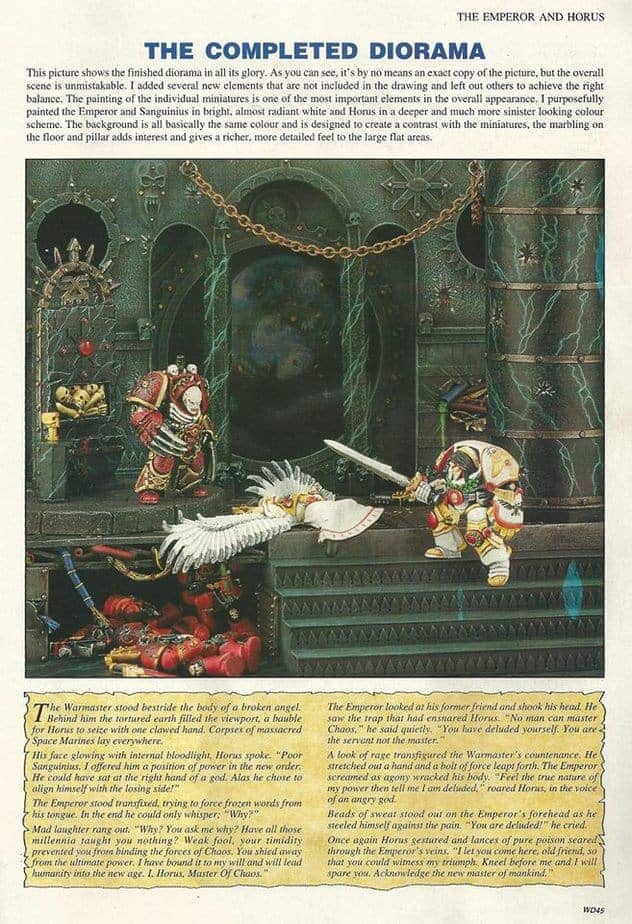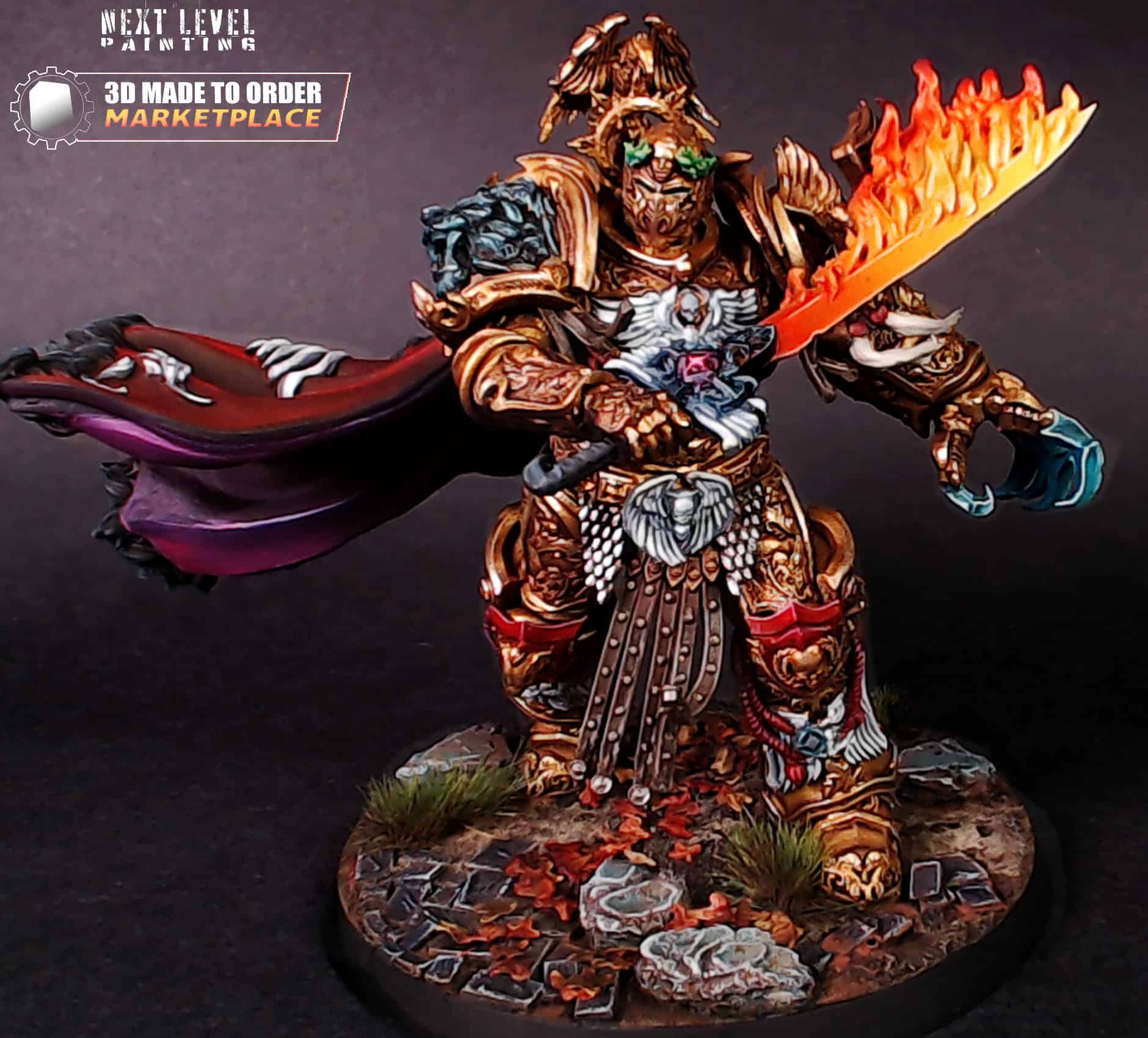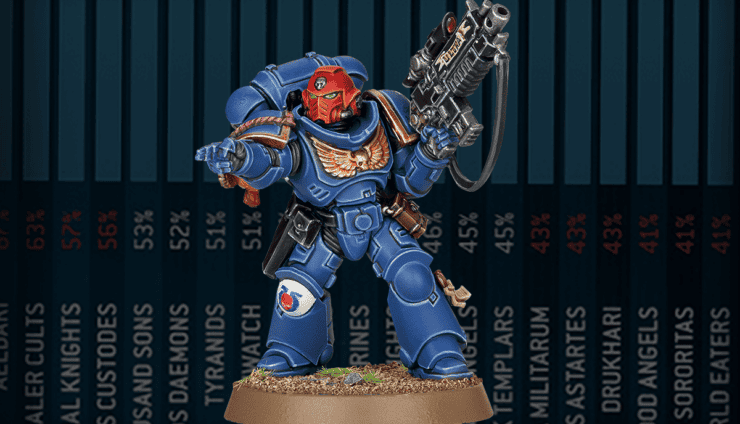Build your own Death of Horus diorama and relive the epic Warmaster vs the Emperor battle with Mike McVey’s legendary work!
Horus vs the Emperor Diorama: A Tribute to the Death of Horus
Whether you’re a Warhammer lore fanatic or just someone who appreciates a good ol’ fashioned father-son (Horus vs. Emperor) throwdown with some god-like powers thrown in, you’ve come to the right place. The final battle between the Emperor of Mankind and his favorite traitor son, Horus, is one of the most epic moments in Warhammer 40k history—and it’s a scene that fans have been recreating on their hobby tables for decades.

- The Epic Showdown: The History of Horus’ Final Battle
- The Iconic Diorama: A Visual Representation of Horus’ Death
- How to Create Your Own Death of Horus Diorama
- Painting Tips and Techniques for a Stunning Diorama
- Frequently Asked Questions About the Death of Horus Diorama
The Epic Showdown: The History of Horus’ Final Battle
 The Battle of Terra: Prelude to Horus’ Downfall
The Battle of Terra: Prelude to Horus’ Downfall
Ah, Terra—the heart of the Imperium, the crown jewel of humanity, and the place where things went very, very wrong. By the time Horus brought his forces to Terra’s doorstep, the galaxy was in chaos, but it hadn’t always been that way. Once upon a time, Horus Lupercal was the Emperor’s most beloved son, a Primarch among Primarchs. The Emperor trusted him so much that he named Horus Warmaster, effectively making him the second most powerful figure in the Imperium.
But power corrupts. And in Horus’ case, it came with a side order of daemonic influence. After a little too much meddling with the forces of Chaos, Horus turned from golden boy to betrayer. The Warmaster had a galaxy-spanning civil war in his hands, and the culmination of that war led him straight to Terra.
Before things reached their dramatic conclusion, Horus had to blast his way through the Solar System. The Luna naval bases? Gone. Terra’s defenses? Crushed. He did it all with brutal efficiency, and after thirty days of merciless bombardment, Terra was in ruins. Horus, watching it all from orbit, was waiting for his moment. He knew that time was short—the loyalist Legions were returning, and soon his numbers advantage would be toast. So, he lowered the shields of his flagship, the Vengeful Spirit, issuing an open invitation to the Emperor himself.
The Betrayal of Horus: Understanding Horus Lupercal’s Tragic Transformation

Horus’ fall began on a planet called Davin, where he was mortally wounded and subsequently “healed” by the dark powers of Chaos. But, like with most things involving the Ruinous Powers, it wasn’t exactly a clean deal. Horus was swayed, manipulated by whispers of godhood and the idea that his father, the Emperor, had been hiding secrets from him all along. It didn’t take long for Horus to turn his back on everything he once held dear.
The most painful part of his fall? Horus genuinely believed he was doing the right thing. Convinced that the Emperor had abandoned humanity’s ideals, Horus sought to remake the Imperium in his own image—one where he, not his father, was the guiding light. Of course, it didn’t hurt that Chaos had amplified his ambitions, whispering sweet nothings about absolute power in his ear.
Siege of Terra: A Brief Overview of the Battle That Led to the Emperor’s Final Confrontation with Horus

For fifty-five days, Terra was a nightmare of explosions, rubble, and endless waves of traitor marines. The Palace walls were under constant assault, and it was only a matter of time before Horus’ forces broke through. The defenders fought valiantly, but Horus knew his real enemy wasn’t on the walls; the Emperor was the prize, and everything else was just foreplay.
As Horus stood aboard the Vengeful Spirit, he made a fateful decision: to drop his ship’s shields and force a final, decisive confrontation. He was running out of time, and if the Emperor’s loyalist Legions reached Terra, Horus’ advantage would evaporate. The stage was set for the ultimate showdown.
Read all about the siege in the amazing series below!
- Audible Audiobook
- John French (Author) - Jonathan Keeble (Narrator)
- English (Publication Language)
- 05/18/2019 (Publication Date) - Black Library (Publisher)
Last update on 2025-05-28 / Affiliate links / Images from Amazon Product Advertising API
The Final Duel: Emperor of Mankind vs. Horus
 Sanguinius’ Sacrifice: The Fallen Primarch’s Role in the Battle
Sanguinius’ Sacrifice: The Fallen Primarch’s Role in the Battle
Before the Emperor and Horus could lock horns, another player had to make his mark on this tragic stage: Sanguinius, the angelic Primarch of the Blood Angels. Often depicted as one of the noblest and purest of the Emperor’s sons, Sanguinius found Horus first on the Vengeful Spirit.
Now, here’s the thing about Sanguinius—he was a force of nature in battle, but even he wasn’t a match for Horus, who had been boosted by all four Chaos Gods. Sanguinius fought bravely, but the Warmaster struck him down, leaving the Primarch’s lifeless body at his feet. Horus might have been the betrayer, but Sanguinius’ death added a layer of personal loss to the Emperor’s mission. It wasn’t just about saving humanity anymore; it was also about avenging one of his beloved sons.
The Emperor’s Victory and the Death of Horus: How the Emperor Ultimately Defeated His Traitorous Son
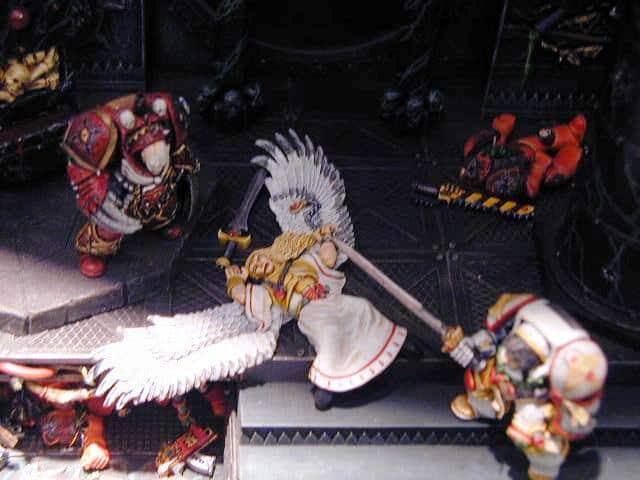
But here’s the thing: the Emperor was holding back. Even after everything, he still loved Horus and didn’t want to destroy him outright. Unfortunately, Horus showed no such hesitation. The Warmaster was out for blood, and it wasn’t until Horus inflicted a grievous wound on the Emperor that the old man finally let loose. With all mercy burned away, the Emperor unleashed his full power and obliterated Horus in a final, devastating blow.
The Emperor won, but at a cost. Mortally wounded, he was carried back to the Golden Throne, where he would remain for the next 10,000 years, a living corpse. The Imperium was saved, but its leader was forever changed, leaving humanity in a grim, uncertain future.
And Horus? He was erased so thoroughly from existence that not even Chaos could bring him back. His death marked the end of the Heresy, but the scars of his betrayal would haunt the galaxy for millennia to come.
The Iconic Diorama: A Visual Representation of Horus’ Death
There are moments in Warhammer 40K that transcend the written lore and become immortalized in the form of stunning visuals. One of the most famous among them is the diorama depicting the death of Horus. For fans both new and old, this iconic piece of Warhammer history captures the climactic duel between Horus and the Emperor at the peak of the Horus Heresy. It’s more than just a set of miniatures on a battlefield—it’s a snapshot of tragedy, betrayal, and the fate of humanity hanging in the balance. Let’s break down why this diorama has left such an indelible mark on the Warhammer universe.
The Influence of Mike McVey’s Diorama on Warhammer Lore
 Origin in White Dwarf: The Role of White Dwarf Magazine in Introducing This Diorama to the Warhammer Community
Origin in White Dwarf: The Role of White Dwarf Magazine in Introducing This Diorama to the Warhammer Community
Mike McVey (check out his Instagram here), a name that still resonates in Warhammer circles, was the genius behind this legendary diorama. Back in the day, before social media flooded us with daily Warhammer updates, White Dwarf magazine was the go-to source for all things grimdark. Issue #45 was a game-changer, as it first introduced this powerful visual of the final confrontation between Horus and the Emperor.

 Impact on Horus Heresy Lore: How the Diorama Inspired Warhammer Artists and Writers for Over Two Decades
Impact on Horus Heresy Lore: How the Diorama Inspired Warhammer Artists and Writers for Over Two Decades
The diorama wasn’t just a pretty display; it was a moment of inspiration for countless artists and writers within the Warhammer community. For over two decades, the image of the Emperor standing over the fallen Horus, with Sanguinius lying motionless at their feet, became a wellspring of creativity. It inspired writers to delve deeper into the story of Horus’ betrayal and gave artists a foundation for how to depict the epic, tragic final battle.

Adrian Smith’s Artwork: The Inspiration for the Diorama
 Classic Black-and-White Illustration: How Adrian Smith’s Artwork Captures the Intense Emotion of the Final Battle
Classic Black-and-White Illustration: How Adrian Smith’s Artwork Captures the Intense Emotion of the Final Battle
Behind every great diorama is often an equally great piece of art. In this case, the foundation for McVey’s diorama came from none other than Adrian Smith’s haunting black-and-white illustration. Smith’s artwork distilled the essence of the Horus Heresy’s climactic moment into a single image—a stark, emotionally charged portrayal of the Emperor facing his fallen son.
Smith’s style, known for its gritty realism and dark atmosphere, captured the raw intensity of the moment. His Horus wasn’t just a traitor; he was the embodiment of hubris and tragedy, standing against his creator and former mentor. The Emperor, regal and divine, is painted as a father about to make the ultimate sacrifice. The duality of their conflict, both personal and galactic in scope, is masterfully rendered in Smith’s work. It’s this emotional depth that turned a simple line drawing into something iconic.
Translating Art into a Diorama: How Artists Turned This Iconic Illustration into a Three-Dimensional Masterpiece
Turning a powerful 2D image into a fully realized 3D diorama is no small task, but McVey took up the challenge. The trick to translating Adrian Smith’s illustration into miniature form was maintaining that emotional weight while still making it functional for display. McVey’s attention to detail was key here. Every miniature was painstakingly crafted to reflect the characters’ emotions—Horus’ defiance, the Emperor’s determination, and the tragic death of Sanguinius, lying motionless at their feet.
The use of dynamic poses and clever basing gave the diorama a sense of movement, as if the entire scene had been frozen in time. This wasn’t just a couple of miniatures standing next to each other on a table—this was storytelling through form. The result was nothing short of spectacular. The transition from Smith’s two-dimensional canvas to McVey’s fully realized 3D masterpiece made the final battle between Horus and the Emperor feel tangible, pulling viewers into the grim reality of the Horus Heresy’s conclusion.
How to Create Your Own Death of Horus Diorama
So, you’ve been inspired by the epic final showdown between the Emperor and Horus, and now you want to recreate this dramatic scene in miniature form. Whether you’re a seasoned hobbyist or someone just looking to get into diorama building, crafting a “Death of Horus” masterpiece is a fun way to pay tribute to one of the most iconic moments in Warhammer 40K lore. But where do you start? From picking the right miniatures to building a suitably grim battlefield, let’s walk through how to create your own death of Horus diorama.
Essential Miniatures for the Diorama
 The Emperor of Mankind: Where to Find High-Quality Miniatures and Parts
The Emperor of Mankind: Where to Find High-Quality Miniatures and Parts
No “Death of Horus” diorama would be complete without the Emperor himself. After all, he’s the star of the show—galactic overlord, father to the Primarchs, and all-around badass. When you’re looking for an Emperor miniature, quality is key. You want a figure that captures his regal presence and battle-worn appearance, complete with his iconic armor and glowing golden halo.
Luckily, there are plenty of options online. For a high-quality Emperor miniature, we recommend the ruler above by 3DArtGuy, which you can score here!
Horus Lupercal: Sourcing a Primarch Model That Captures the Essence of the Warmaster

Forge World offers some excellent options for Horus Lupercal miniatures, complete with his menacing power armor and a face that says, “I really messed up, but I’m not sorry.” Look for details like his wolf pelt and the eye of Horus symbol—it’s all about the little things when it comes to capturing the Warmaster in all his fallen glory. Check out the GW version here!
Sanguinius: Selecting a Miniature for the Fallen Primarch

For this, look for a Sanguinius model that conveys his angelic beauty even in defeat. The bloodied wings, the fallen grace, all help to remind viewers that this is a tragic scene, not just a battle. Forge World’s Primarch line offers some solid picks, though custom models from third-party creators can add a personal touch. Check out the GW version here!
Terrain and Scenic Elements for Your Diorama
 Battlefield Accessories: How to Create or Source the Right Terrain and Ruins for the Backdrop
Battlefield Accessories: How to Create or Source the Right Terrain and Ruins for the Backdrop
You’ve got the key players—now you need to set the stage. The battle takes place aboard Horus’ flagship, The Vengeful Spirit, so you’re going to want a setting that screams “crumbling warship on the verge of collapse.” Think Gothic architecture, broken machinery, and plenty of debris.
There are some great kits out there that offer pre-made terrain pieces perfect for recreating this grim scene. Look for modular terrain sets, such as those offered by Games Workshop or other suppliers that can be pieced together to form shattered floors, ruined walls, and ominous corridors.
Adding broken banners, rubble, and shattered weaponry will give your diorama that extra level of detail. You can also build some of your own terrain using foam, plaster, or even bits of old models to create that chaotic, war-torn atmosphere. If you have a 3D printer, that might be your best bet, but for those who don’t, you can check out what GW has to offer.
Creating a Grimdark Atmosphere: Tips for Painting and Weathering to Capture the Grim, Dark Aesthetic of Warhammer 40K
Now for the fun part—painting. Warhammer 40K is nothing if not grimdark, and your diorama needs to reflect that. The key here is to give everything a weathered, battle-damaged look. Start by priming your models and terrain with dark, muted tones. Black, dark grey and gunmetal shades should be your base.
For the Emperor, aim for that iconic golden armor, but don’t make it too shiny—he’s been through hell and back, after all. Add subtle washes to give the armor a slightly worn, tarnished look. Horus, on the other hand, should be painted with darker, more menacing colors—deep blacks, reds, and greys—with plenty of weathering to show that he’s fully embraced the darker side.
When it comes to terrain, focus on making everything look old, worn, and battle-scarred. Dry brushing techniques work wonders here. Dust, rust, and grime should cover the walls and floors, while darker shades and shadows give the whole scene a moody, ominous vibe. Don’t be afraid to get creative with weathering powders or sponging techniques to add scuffs, burns, and battle damage.
Painting Tips and Techniques for a Stunning Diorama
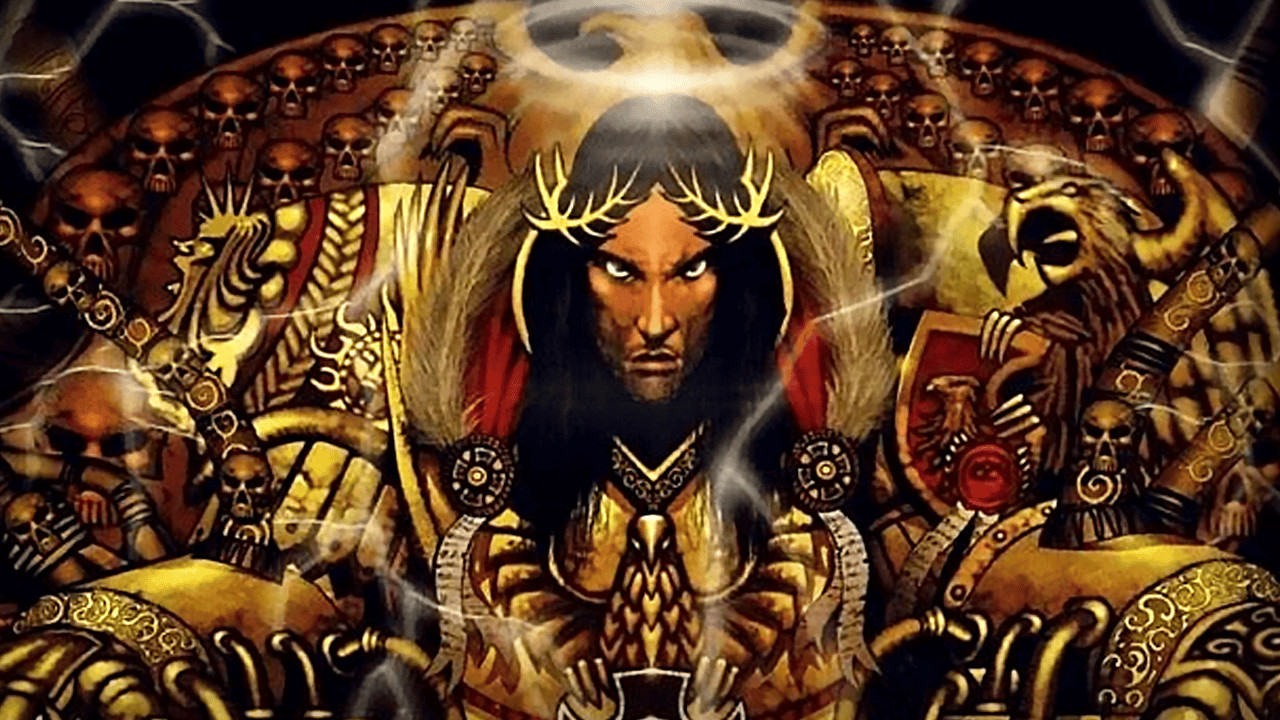
Replicating the Iconic Look: Color Schemes and Inspiration

Using Adrian Smith’s Horus Vs The Emperor Artwork as a Guide: How to Match the Diorama’s Colors to the Original Art
Adrian Smith’s black-and-white artwork is hauntingly beautiful and oozes emotion, but translating that into color can be tricky. The key here is to take the mood of his work and layer in the iconic color schemes of the characters while keeping that gritty, somber feel. Horus, with his dark and brooding armor, contrasts beautifully with the Emperor’s shining gold, all set against the shadowy backdrop of the Vengeful Spirit.
A good place to start is to study the shading and light contrasts in Smith’s art. Think dark, muted tones for Horus and Sanguinius and glowing, ethereal highlights for the Emperor. His art may not have color, but it screams intensity—your paint job should do the same.
Key Color Choices: Choosing the Right Hues for Horus, the Emperor, and Sanguinius

The Emperor, on the other hand, is all about contrast. Golds that shimmer, whites that glow, and some deeper tones to show he’s been through a few rounds in the fight. His armor needs to look like it’s been through the ringer but still carries that god-like radiance.
Sanguinius is your tragic figure, so soft, muted reds, and whites are perfect for his wings and armor. A few blood splatters (naturally) will highlight the tragic end of the angelic Primarch. If you want more painting techniques, check out all of our guides here!
Advanced Painting Techniques for Warhammer Dioramas
 Using Gold Pigments on the Emperor: How to Replicate the Golden Armor of the Emperor
Using Gold Pigments on the Emperor: How to Replicate the Golden Armor of the Emperor
If you’re going for that I’m-the-God-Emperor-of-Mankind look, then nothing less than perfection will do for his armor. Gold pigments are your best friend here. The Army Painter offers a fantastic range of gold colors that you can mix with medium to give the Emperor’s armor that almost luminous shine. Layering is key—start with a base coat of a darker gold or bronze, and then gradually build up to the brightest highlights. It’ll give his armor depth and make him stand out like the galactic deity he is.
Weathering and Effects: Techniques for Giving Your Diorama a Battle-Worn, Grimdark Look

For Horus and the battlefield, think scorched metal, cracked stone, and just enough weathering to suggest they’ve seen better days. The Emperor’s armor might need some scratches too—after all, no one walks away from Horus without taking a few hits.
Frequently Asked Questions About the Death of Horus vs The Emperor Diorama
 What Was the Importance of Horus’ Death in Warhammer Lore?
What Was the Importance of Horus’ Death in Warhammer Lore?
Horus’ death is the moment that changed everything in Warhammer 40K. Once the Emperor’s favored son and Warmaster of his legions, Horus fell to the temptations of Chaos and launched a devastating civil war—The Horus Heresy—that nearly tore the Imperium apart. By the time Horus and his forces arrived at Terra, the galaxy had been ravaged by his betrayal.
The battle between Horus and the Emperor aboard the Vengeful Spirit isn’t just a fight between father and son. It’s a defining moment in the history of the Imperium. Horus, consumed by the powers of the Chaos Gods, faced off against the Emperor in a duel that would decide the fate of humanity. Though the Emperor defeated Horus, the cost was enormous. The Emperor was mortally wounded, destined to spend eternity in a half-dead state on the Golden Throne, and the Imperium entered a grimdark future of stagnation and decay.
In short, the death of Horus marks the end of the Heresy, but it’s also the start of the Imperium’s eternal struggle to survive in a galaxy full of enemies. This moment is the hinge on which Warhammer 40K lore turns, making it the most important event in the timeline.
What Miniatures Are Needed to Recreate the Death of Horus Diorama?

- The Emperor of Mankind: You can’t have the final duel without the Big Guy himself. Look for miniatures that capture the Emperor’s regal, almost god-like presence, with his golden armor and psychic power practically radiating from him.
- Horus Lupercal: The Warmaster himself needs to look every bit the fallen hero. His armor, dark and menacing, should hint at the corruption within him. Make sure you find a model that includes Horus’ iconic talon and his wolf-pelt cloak.
- Sanguinius: No “Death of Horus” diorama is complete without the fallen angel. Sanguinius, tragically slain by Horus before the Emperor arrived, lies at their feet. You’ll need a model that portrays his grace, even in death, with his blood-stained wings and noble features.
- Terrain and Backdrop: The final battle took place aboard the Vengeful Spirit, so some grimdark spaceship terrain will complete the scene. Think broken machinery, gothic architecture, and a shattered battlefield.
How Can I Paint My Diorama to Look Like the Official Horus Vs the Emperor Art?

- Start with the right color palette: Horus should be dark and brooding—think deep blacks and greens, with splashes of red to hint at his corruption. The Emperor, by contrast, should glow with gold, whites, and ethereal blues. His armor should look divine, but battle-worn.
- Layering is key: Both Horus and the Emperor should have a sense of depth and wear in their armor. Use dry brushing for highlights and shading to give the impression of wear and tear. Add scratches and subtle weathering to show that this battle was hard-fought.
- Sanguinius needs to look angelic: Even in death, Sanguinius should retain his ethereal beauty. Use soft reds for his armor and pale whites for his wings. Add in some dark washes and blood effects to show the tragedy of his fall, but keep his colors light and noble.
- Weather the terrain: The battlefield should look like it’s been through hell. Use rust, grime, and broken bits to give your terrain a properly grimdark feel. Dry brushing with greys and browns will add layers of dirt and battle damage to make everything look well-worn.
Conclusion: The Legacy of the Death of Horus Diorama in Warhammer 40K
 The Enduring Impact of the Diorama of Horus Vs The Emperor on Warhammer Art and Lore
The Enduring Impact of the Diorama of Horus Vs The Emperor on Warhammer Art and Lore
The Death of Horus diorama isn’t just a hobby project—it’s become a cornerstone of Warhammer 40K’s visual and narrative history. When Mike McVey first crafted the diorama, it helped solidify this pivotal moment in the minds of fans, giving a tangible form to the Emperor vs Horus in a final battle. The image of these two titans clashing has been referenced and re-imagined by artists, writers, and fans for decades.
In terms of lore, Horus’ death vs the Emperor’s sacrifice has shaped nearly every story in the Warhammer 40K universe. From the rise of Chaos to the Imperium’s eternal struggle, this moment is what started it all. And the diorama? It’s been a source of inspiration for fans and hobbyists who want to capture a piece of that history on their own hobby desks.
From Warhammer artwork to custom fan-made dioramas, the legacy of Horus’ death lives on. Whether you’re painting miniatures, reading the novels, or simply admiring the scene, this diorama is a reminder of the grand, tragic scale of Warhammer’s galaxy. It’s not just a moment frozen in time—it’s a touchstone for everything Warhammer 40K stands for: sacrifice, betrayal, and the never-ending fight for survival.
All the Latest Warhammer Rules & Model Rumors
What do you think about the Horus vs the Emperor and this amazing Diorama? Will you be trying to make your own?




